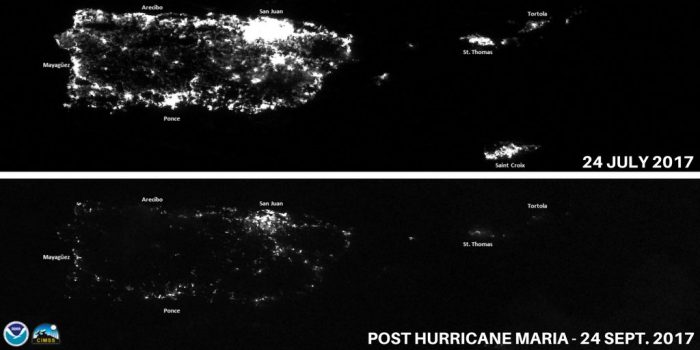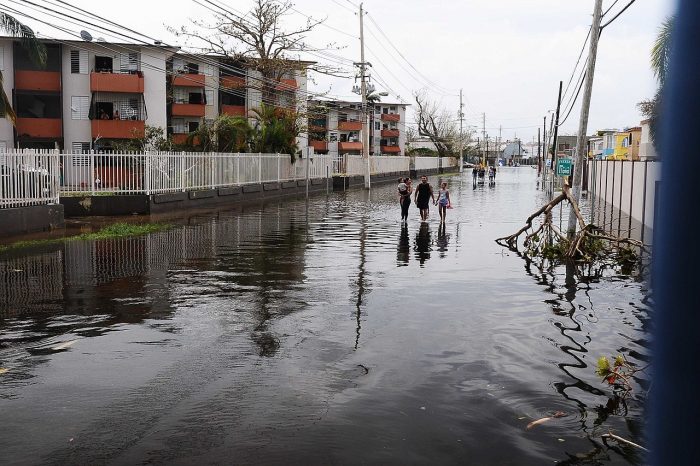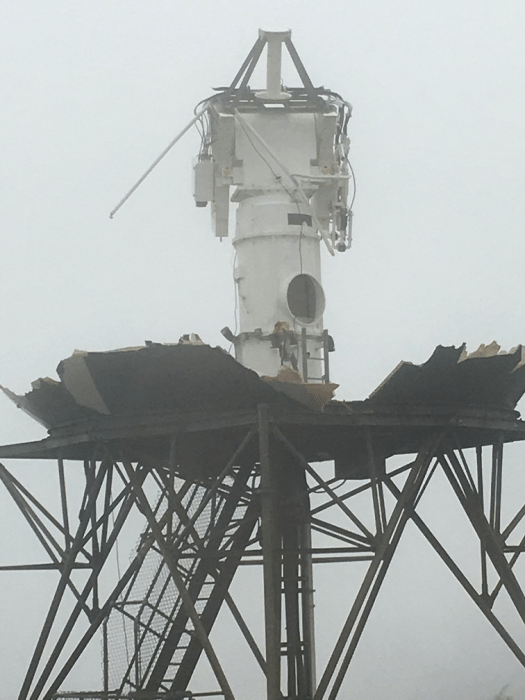By Ruth “Tata” Santiago, J.D. and Salinas, Puerto Rico resident


The power grid of Puerto Rico before and immediately Hurricane María. (September 24, 2017/Public Domain)
The Puerto Rico Electric Grid Debate
SALINAS, PUERTO RICO — Puerto Rico’s capacity for electric generation (about 5800 MW) is nearly double than the amount of energy required at peak-demand (less than 3000MW). After Hurricane María, and the accelerating exodus of Puerto Rican residents, this margin will broaden.
Recent headlines have called for various solutions to the grid’s collapse. Some propose rooftop solar energy, while another proposal advocates for a “hardened” transmission and distribution system. An obvious solution to many is that rooftop solar, and other clean-energy sources would be a better alternative to the existing large power stations dependent on fossil fuels. The proposal for rebuilding the current transmission and distribution system to connect the existing fossil fuel burning plants to generate 97 to 98 percent of Puerto Rico’s electric energy is easily challenged.
Anyone with minimal knowledge about Puerto Rico’s grid is aware that the major transmission lines run from the big plants in southern Puerto Rico to the north and to the San Juan metropolitan region. In doing so, these high voltage lines traverse the central mountain range and dense tropical forests. As Gretchen Bakke noted in her book, The Grid, vegetation, trees, and transmission lines don’t mix well. Trees close to transmission lines have caused blackouts in the past. So, it makes sense to place transmission and distribution lines at shorter distances and, better yet, to generate renewable energy at or near the load or demand centers (i.e., at the places where the energy will be used).
The proponent of the “hardened” grid for Puerto Rico posits that Puerto Rico could be the site of yet another experiment with use of materials for construction of a transmission and distribution system that could be hurricane resistant. While it is true that cement and metal poles have held up better than the wooden poles, it stands to reason that vertical structures of any material will fall or lean dangerously when subjected to hurricane force winds, no matter what materials they are made of.
In fact, the solar installations in Puerto Rico survived the hurricane pretty well. Some solar arrays and rooftop solar panels look intact. A few have sustained damages, especially those that were located near to where Hurricane Maria made landfall. But, in these same areas, the transmission and distribution lines are devastated. Puerto Rico will be more resilient if it implements solar communities, microgrids, energy storage, efficiency and demand management, and other alternatives to the existing large, central fossil-fuel dependent power plants with long-distance transmission.
To transition to a more sustainable electric grid, one of the main obstacles to overcome in Puerto Rico is the enormous influence the fossil fuel industry has over the Puerto Rico Electric Power Authority (PREPA), and on the government of Puerto Rico. Just this past July, residents witnessed the way in which the U.S.-based AES Corporation flexed its economic and political muscle, which led to changing the course of legislation that would have regulated the management of coal combustion waste in Puerto Rico.
If Puerto Rico is to become livable, it’s electric generation needs to be based on local resources and new pathways for energy delivery and management. This is not just a matter of future sustainability. Rather, lives literally depend on it, as hospitals are running out of time and the economy remains at a near standstill due to a lack of electric power and communications.
The Emergency Generator Nightmare
The collapse of Puerto Rico’s electric grid has led to widespread use of diesel or gas emergency generators. One reporter recently told me that Puerto Rico is being referred to by some in the U.S. mainland as the “Generator Island.” Certainly, there has been a scramble to keep refrigerators, lights, appliances, and so on, energized. Hardware stores are seeing astronomical sales of generators, which are literally scooped up as soon as they arrive in the store. The hot and humid aftermath of Hurricane Maria requires that people use at least fans, if not air conditioning, in their homes, and particularly at night. On almost every block, generators ranging in size from small to industrial-sized machines are in use, sometimes day and night. The fumes emitted by these generators are nothing less than noxious, and the noise is unbearable, making sleep very difficult. At night, I battle the noise of the emergency generators by listening to the radio. I also wear a face mask, to cover my nose and mouth, as a way to combat the fumes somewhat.
Regulations applicable to noise control have been put on hold. The fumes from generators are exacerbating respiratory health conditions and the impact of loud noise to the human nervous system has been well documented. Once the Puerto Rico electric grid is up and running, the investment that so many families and businesses have made in emergency generators will be largely unproductive and idle. So, in my view, this is yet another reason for Puerto Rico and other jurisdictions to implement rooftop solar electric generation and alternatives such as energy demand management.
How AT&T and Big Telecom Have Failed Miserably
Hurricane Maria demolished most of the telecommunications towers and antennas in Puerto Rico as it plowed over the island on September 20, 2017. More than three weeks later, telecommunications in Puerto Rico are still extremely hampered. This in turn, has been an obstacle to the relief efforts being carried out by the government, communities, and private agencies. AT&T has been especially slow in repairing its network. On September 27, allegedly 26 percent of cellular communication had been re-established, but this was mostly because 55 percent of Claro’s network, the Mexican telecom giant, was in service. Although the numbers are in dispute, allegedly half of telecommunications service is currently operational. Again, AT&T is trailing in its recuperation efforts. The numbers that the telecom companies are providing do not coincide with those of the Federal Communications Commission. Part of this discrepancy may be due to the fact that telephones sometimes indicate that there is minimal service—one or two bars, but they can’t receive or generate calls or text messages. Puerto Rico has totally embraced cellular telephone and communications. Few landlines are available. The telecommunications giants have a large presence in the Puerto Rico market, but this has not led to competitive prices or greater efficiency.
In fact, the inefficiencies of the telecommunications network in Puerto Rico are crippling the island’s ability to recover from the devastation post Hurricane Maria. It would seem that AT&T, Claro, and other telecommunications conglomerates are not dedicating the resources necessary to provide efficient service in Puerto Rico. The question is whether the government agencies with jurisdiction will protect the public interest and require the telecom industry to provide the service needed for Puerto Rico’s recuperation. AT&T was awarded a large contract with the federal government to set up a telecommunications system during emergency situations. But from where I am standing, the future does not bode well for emergency telecommunications in Puerto Rico.
***
Ruth “Tata” Santiago is a resident of Salinas, Puerto Rico, and a community environmental attorney. She is a board member of Iniciativa de Ecodesarollo de Bahía de Jobos (IDEBAJO) and serves as Comité Diálogo Ambiental’s attorney.




